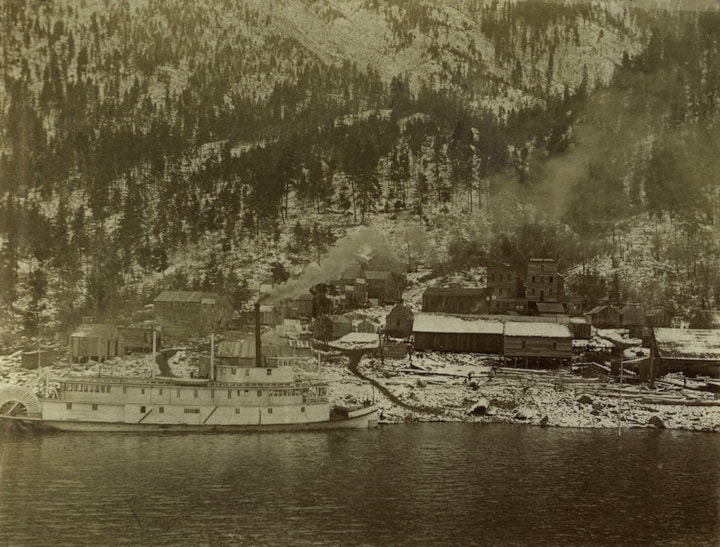Less than two years ago, only one old photo was known to exist of the Kootenay Lake East Shore boomtown of Kuskonook (or Kuskanook). It was in the BC Provincial Archives and showed a bunch of false-fronted buildings with the lake in the background, but didn’t suggest a very large settlement.
Then last year Peter Smith of Victoria shared a mystery photo with me from the Kootenay Lake Archives in Kaslo that was initially identified as Three Forks (a ghost town in the Slocan), but later crossed out and relabelled Ainsworth, and finally crossed out and again labelled Three Forks.
It turned out the photo actually depicted Kuskonook in 1898 — something we deduced from the sign on one building: “Klondyke Hotel, A. Manson, Prop.”
That was Alfred Manson, listed in the 1898 BC civic directory as running the hotel. His great grandson also confirmed Manson had once been a hotelier there. (One of his competitors was Pedro Cherbo, co-proprietor of the Union Hotel and grandfather of Nelson city councillor Robin Cherbo.)
A key reason for the confusion was that the lake wasn’t visible in the photo, which otherwise indicated a lively place, with many more people and false-fronted buildings than in the BC Archives shot.
None of the buildings was in both photos, but any lingering doubt was resolved when Howard Boyle took a photo from the same location and overlayed the two — the mountains lined up perfectly and Highway 3A was shown running through what was then Main St.
Now magically, improbably, a third photo of Kuskonook has appeared — along with what could be many others. And it’s a heck of an image, providing us with a much better sense of the town, and explaining how the previous two photos relate to each other.
I’m indebted to noted Kootenay Lake historian Michael Cone for discovering it and telling me. He came across it among the Uno Langmann photographs in the University of BC’s digitized collections.
(Last year Langmann, a famed art collector, donated 18,000 historical photos to UBC, which has been making them available online. The site is providing a wealth of rare and unusual photos of this area — it’s the same place where I recently found a photo of the hotel at Porto Rico Siding.)
The photo in question was part of an album of 90 images described as “focused on early British Columbian life taken throughout the province.”
It’s taken from Kootenay Lake in winter and shows the SS Alberta docked at the Kuskonook wharf.
There are easily two dozen wooden buildings, some on stilts. It was a rough and ready town, slapped together in a hurry to cash in on advancing railway lines. One building’s sign says “Saloon” in big letters.
Standing next to the Klondyke Hotel is the four-storey Windsor Hotel, whose roof sign is visible upon zooming in. According to the 1898 civic directory, Frank Twombly and Thomas S. Shanks were its proprietors. Shanks also had a hotel in Salmo in 1897 but went broke.
Fred Vipond, who lived there as a young boy in 1899, described it in Kootenay Pathfinders thusly: “Kuskonook proved to be a well-established town pleasantly situated … Kuskonook’s seven hotels, the Anderson House, Butte, International, Kalama, Klondike, Union, and Windsor, had sprung up during the CPR construction [and] remained open for business, as did Charles Wright’s general store and other business establishments. Two provincial constables remained on the scene because Kuskonook had seen some rowdy times several months earlier …”
 Most of the buildings, however, were destroyed by fire in March 1900, dealing a near-death blow to the settlement — so we know the photo was taken before then.
Most of the buildings, however, were destroyed by fire in March 1900, dealing a near-death blow to the settlement — so we know the photo was taken before then.
This photo also reveals the BC Archives shot was taken looking west down 7th Ave. while the Kootenay Lake Archives picture is of Main St. looking south. (The only other thoroughfare of consequence was A Ave., which ran parallel to Main St., further up the hillside.)
Like the Kootenay Lake Archives photo of Kuskonook, this one was misidentified — as Trout Lake City. The existence of another Windsor Hotel in the latter community probably led to the erroneous description.
The same album also contains another picture that is very likely Kuskonook (seen at left), of two men standing in front of the steps of a one-storey building with what looks to be the Windsor behind them. The ground is strewn with boulders.
Many other photos also appear to be of the south end of Kootenay Lake, but aren’t as easily identified. Some show the SS Marion, a sternwheeler that plied the Duncan River and Kootenay Lake prior to 1907.
One especially intriguing shot is of a couple of canvas tents on a beach with the Marion and a barge in the background and many men milling about. One tent bears the crude sign “Boat to conect [sic] with Ainsworth —> Albeta [sic]/Lodging.”
In two others, a young boy, a dead ringer for Buster Brown, stands next to a shack with the sign “Homemade bread for sale.”
The same child appears in another shot on horseback outside a one-storey building, probably his house. Yet another is of four well-dressed women and two children on the house’s porch. Another view of the same house shows one of the planter boxes is made from a piece of lumber labelled “A. [or O?] Robinson logging camp.”
But where was Robinson’s camp? That’s more grist for the historical mill.
